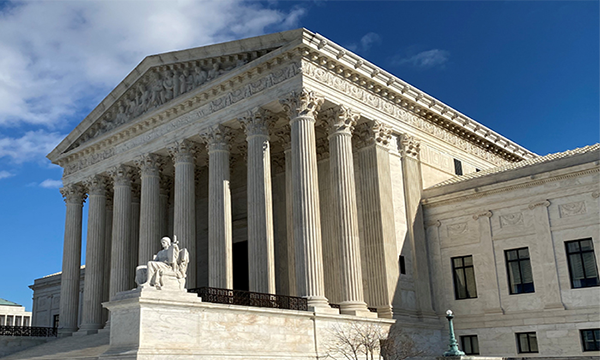Did the U.S. Supreme Court last week engage in a course correction in its approach to gun regulation and the Second Amendment?
 A retired justice once said that history reveals that when the court moves too far, too fast in a direction that is ahead of the American public, it begins to self-correct. There appeared to be a sense of that in the 8-1 ruling in United States v. Rahimi.
A retired justice once said that history reveals that when the court moves too far, too fast in a direction that is ahead of the American public, it begins to self-correct. There appeared to be a sense of that in the 8-1 ruling in United States v. Rahimi.
Zakey Rahimi was under a domestic violence restraining order after he assaulted and threatened his girlfriend and their child. He also fired his gun in a series of five incidents over a period of months. Rahimi violated the order and threatened a different woman. Rahimi was indicted on one count of possessing a firearm while subject to a domestic violence restraining order, in violation of a federal law, 18 U. S. C. §922(g)(8). At the time, a violation was punishable by up to 10 years’ imprisonment, but it is now 15 years.
Rahimi was convicted and appealed. He challenged the constitutionality of §922(g)(8), claiming it violated the Second Amendment right to keep and bear arms. His appeals failed until after the Supreme Court in 2022 announced a new test for courts to apply to laws being challenged under the Second Amendment.
Known as the “Bruen case,” the six-justice conservative majority, led by Justice Clarence Thomas, said that to be constitutional, a gun restriction had to be consistent with the nation’s historical tradition of firearm regulation. Courts were to look at that tradition prior to 1900. They didn’t have to find a “twin” for the challenged regulation but at least something analogous to the regulation.
The U.S. Court of Appeals applied the new test to Rahimi’s case and ruled that there was nothing in the historical tradition that supported the federal law.
It was clear during oral arguments in the Supreme Court in November 2023 that a majority of justices did not want to strike down the federal law. It was also clear that if the Court had struck it down, public backlash would have been swift, given the seriousness of domestic violence, particularly to women, and its danger to police. And the justices surely were aware of complaints by a number of judges about the new test. Those judges said they were not historians and had neither the skill, time nor manpower to do the research needed to answer the constitutional question.
In upholding the federal law, the majority, led by Chief Justice John Roberts Jr., did two important things. First, as applied to Rahimi’s challenge, Roberts said two types of historical laws supported the federal law. Those laws were surety laws and “going armed” laws. Surety laws, he said, were a form of preventive justice. Someone suspected of future misbehavior was required to post a bond or go to jail. “Going armed” laws punished those who threatened others with firearms. Roberts said the federal law “fit neatly” within the tradition of surety and “going armed” laws.
Second, and most importantly, Roberts said the Court’s prior gun decisions (Bruen, Heller, and McDonald) were not meant “to suggest a law trapped in amber.” The appropriate analysis, he wrote, “involves considering whether the challenged regulation is consistent with the principles that underpin our regulatory tradition. The law must comport with the principles underlying the Second Amendment, but it need not be a ‘dead ringer’ or a ‘historical twin.’’
Justice Sonia Sotomayor, joined by Justice Elena Kagan, concurred in Roberts’ opinion. Both women had dissented in the 2022 Bruen case. This time, Sotomayor said Roberts clarified an important methodological point by emphasizing the focus on principles in the historical analysis.
“In short, the Court’s interpretation permits a historical inquiry calibrated to reveal something useful and transferable to the present day, while the dissent would make the historical inquiry so exacting as to be useless, a too-sensitive alarm that sounds whenever a regulation did not exist in an essentially identical form at the founding,” Sotomayor wrote.
Justice Thomas was the lone dissenter. “The Court and Government do not point to a single historical law revoking a citizen’s Second Amendment right based on possible interpersonal violence,” Thomas wrote.
Interestingly, Justice Ketanji Brown Jackson, who concurred in the majority opinion, noted that she would have dissented in the 2022 gun decision if she had been on the bench. She also said the Court has yet to find a “workable standard” for judging the constitutionality of gun regulations.
“By underscoring that gun regulations need only ‘comport with the principles underlying the Second Amendment,’” Jackson, who has called herself an originalist, wrote, “today’s opinion inches that ball forward. But it is becoming increasingly obvious that there are miles to go. Meanwhile, the Rule of Law suffers. That ideal—key to our democracy—thrives on legal standards that foster stability, facilitate consistency, and promote predictability. So far, Bruen’s history-focused test ticks none of those boxes.”
Seven of the nine justices felt compelled to write opinions in the Rahimi case. With the exception of the court’s three liberal justices, the conservative majority appears to stand firmly behind Thomas’ history and tradition test. So what to make of Roberts’ opinion? A softening, more realistic approach to the constitutional analysis, or simple clarification?
The answer will have to await more gun cases before the justices. And, that is very likely to come sooner rather than later as the lower courts attempt to answer those questions for themselves.
Marcia Coyle is a regular contributor to Constitution Daily and PBS NewsHour. She was the Chief Washington Correspondent for The National Law Journal, covering the Supreme Court for more than 30 years.







